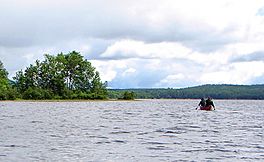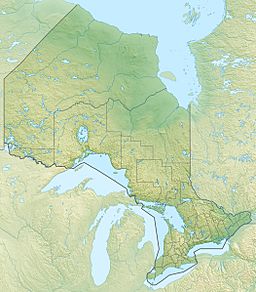Lake Talon facts for kids
Quick facts for kids Lake Talon |
|
|---|---|

Grasswell Point, roughly the centre of Lake Talon
|
|
| Location | Nipissing, Ontario, Canada |
| Coordinates | 46°18′16″N 79°03′22″W / 46.30444°N 79.05611°W |
| Type | Lake |
| Part of | Ottawa River drainage basin |
| Primary inflows | Mattawa River, Kaibuskong River |
| Primary outflows | Mattawa River at Talon Chute |
| Max. length | 11.3 km (7.0 mi) |
| Max. width | 1.7 km (1.1 mi) |
| Average depth | 67 m (220 ft) |
| Surface elevation | 196 m (643 ft) |
| Settlements | Blanchard's Landing |
Lake Talon is a beautiful lake located in the Nipissing District of Ontario, Canada. It is an important part of the Mattawa River system. This means its waters eventually flow into the larger Ottawa River drainage basin.
Most of Lake Talon is found within Bonfield Township. The rest of the lake stretches into Calvin Township and a wilder area called Olrig Township.
Contents
Discover Lake Talon: A Popular Summer Spot
Lake Talon is a very popular place, especially in the summer. Many people own cottages along its shores. You will find most of these cozy cottages on the southern side of the lake. It's a great spot for families and friends to enjoy the outdoors.
What Flows In and Out of Lake Talon?
The main rivers that bring water into Lake Talon are the Mattawa River and the Kaibuskong River. These rivers keep the lake fresh and full. The water then flows out of Lake Talon through the Mattawa River. This outflow happens at a place called Talon Chute, which eventually leads to the Ottawa River.
Protecting Lake Talon: A Provincial Park
Most of Lake Talon and its surrounding land are protected. They are part of the Mattawa River Provincial Park. This park helps keep the lake and its natural environment safe. One area not included in the park is Kaibuskong Bay.
Learning at Lake Talon: A University Field Station
Did you know that Nipissing University has a special place here? They have a field station on the north shore of the eastern part of the lake. This station is used for studying nature and the environment. It's a place where students and scientists can learn more about lakes and their ecosystems.


